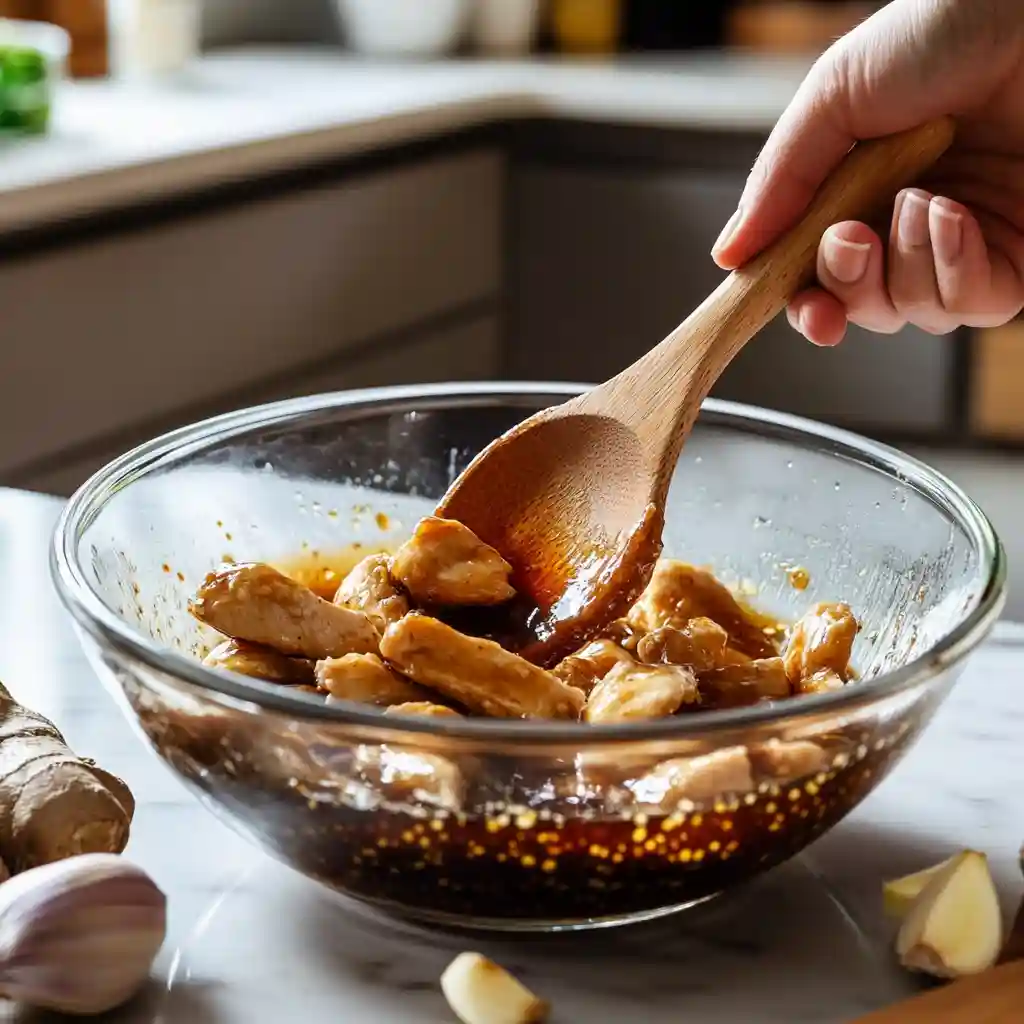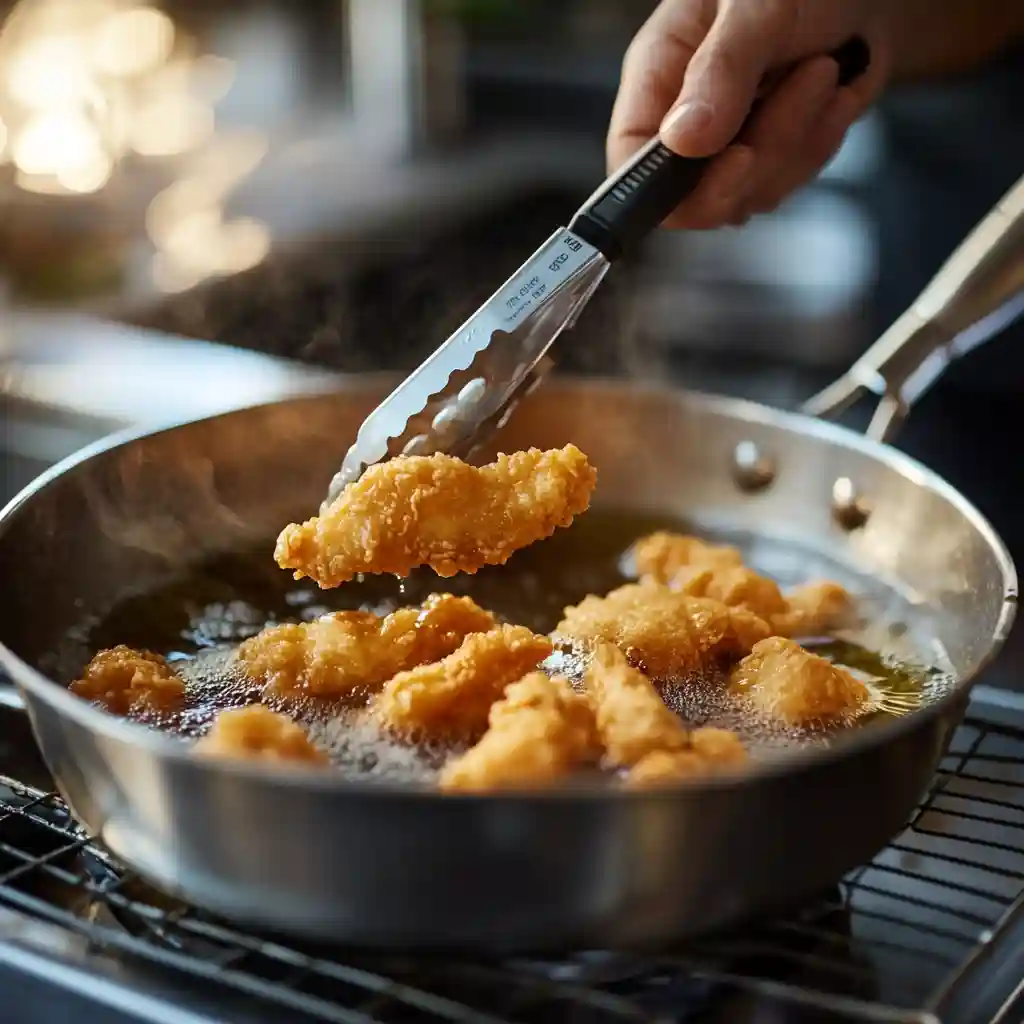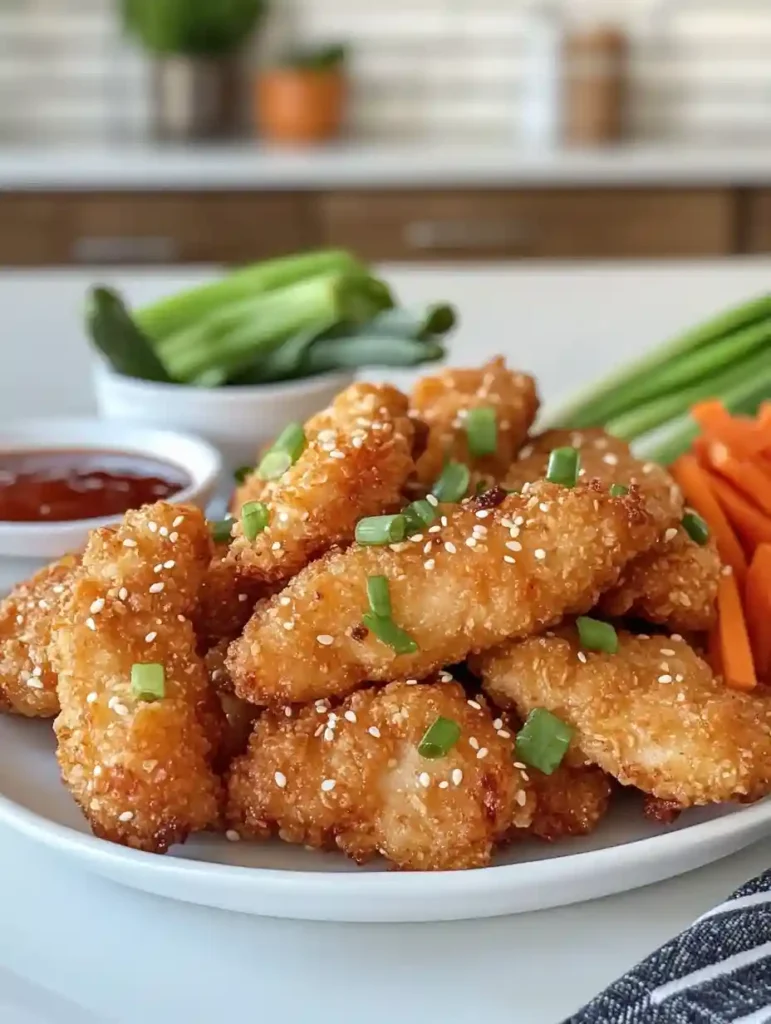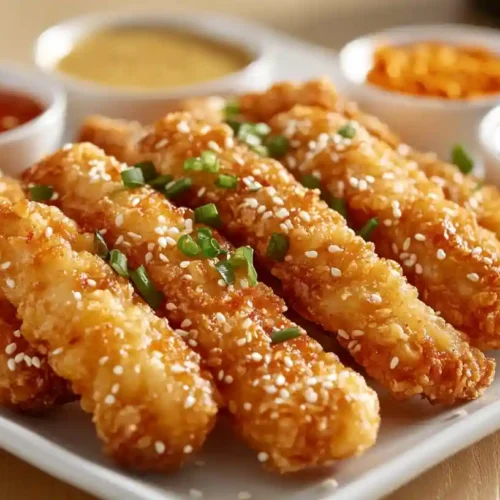Introduction
Have you ever wondered what makes Chinese chicken fingers irresistibly crispy and flavorful, yet so easy to make at home? This popular appetizer has won hearts around the world with its perfect balance of crunchy coating and tender chicken inside. Whether served as a snack, party finger food, or part of a full meal, Chinese chicken fingers are a go-to choice for many food lovers seeking that satisfying Asian-inspired taste.

In this detailed Chinese chicken fingers recipe, we’ll explore everything from the dish’s fascinating history and key ingredients to step-by-step preparation methods. You’ll also discover tasty variations, chef’s tips for perfect results, nutritional insights including calories, and handy storage advice. Get ready to master this delicious treat and impress your family and friends!
Table of Contents
The History and Name of Chinese Chicken Fingers
Origins and Evolution of Chinese Chicken Fingers
Chinese chicken fingers, while widely enjoyed today as a crispy, fried appetizer, have roots that blend traditional Chinese cooking techniques with Western fast-food influences. The concept of breaded and fried chicken pieces draws inspiration from classic Chinese frying methods used for dishes like General Tso’s chicken and sweet and sour chicken. Over time, these evolved into finger-friendly versions that made the dish easy to eat and share, especially in North America and other international markets where Chinese-American cuisine developed its own identity. Today, Chinese chicken fingers combine Asian flavors like soy sauce, ginger, and garlic with a crunchy coating, appealing to a broad range of palates worldwide.
Different Names and Regional Variations
You may find this dish referred to by several names: Chinese chicken tenders, crispy chicken fingers, or simply Asian-style chicken strips. While the core idea remains similar, bite-sized, breaded, and fried chicken, regional variations differ in seasoning, sauces, and cooking techniques. For example, in some areas, the chicken fingers are dipped in a sweet and sour glaze, while others may offer spicy Szechuan-style coatings. In the UK, the term “chicken fingers” is often interchangeable with “chicken goujons,” highlighting slight cultural differences but the same beloved crispy treat.
Common Questions and Misconceptions
Many food enthusiasts ask about the official “Chinese chicken fingers name,” which varies depending on the region and recipe style. Some consider “chicken fingers” as an Americanized name, while authentic Chinese menus may list similar items under different titles like “crispy chicken strips” or “fried chicken bites.” Another frequent question is about finding the best Chinese chicken fingers, a subjective matter influenced by personal taste, local recipes, and quality of ingredients. Ultimately, the best Chinese chicken fingers are those freshly made with a crispy, well-seasoned coating and tender, juicy chicken inside.
Ingredients and Utensils for Perfect Chinese Chicken Fingers
Essential Ingredients for Chinese Chicken Fingers
To make authentic and crispy Chinese chicken fingers, you’ll need a selection of fresh and flavorful ingredients. Here’s what goes into the recipe:

- Chicken breast: Boneless and skinless, cut into finger-sized strips. Fresh chicken breast is best for tender results.
- Cornstarch: Helps create a light, crispy coating when combined with the batter.
- Soy sauce: Adds that unmistakable umami flavor typical of Chinese cuisine.
- Garlic and ginger: Freshly minced to infuse the chicken with aromatic notes.
- Panko breadcrumbs: These Japanese-style breadcrumbs give extra crunch and a golden finish.
- Sesame oil: A small amount enhances the aroma and depth of flavor.
- Eggs: Used in the batter to help the coating stick to the chicken.
- Salt and pepper: For seasoning.
If you’re wondering “Chinese chicken fingers where to buy” ingredients, most of these can be found at local supermarkets or Asian grocery stores. For alternatives, if panko breadcrumbs are unavailable, regular breadcrumbs or crushed cornflakes can work, though panko is preferred for texture.
Kitchen Tools Needed
Having the right utensils makes cooking easier and yields better results. For Chinese chicken fingers, prepare the following:
- Deep fryer or a deep, heavy-bottomed pan: For frying the chicken strips evenly.
- Cooking thermometer: To monitor oil temperature and ensure safe frying (ideal range: 350–375°F / 175–190°C).
- Mixing bowls: For marinating the chicken and preparing the batter.
- Tongs: For safely placing and removing chicken fingers from hot oil.
- Wire rack: To drain excess oil and keep the chicken crispy after frying.
Tips for Selecting Fresh Chicken and Quality Ingredients
The quality of your chicken fingers starts with the chicken itself. Choose fresh, high-quality chicken breast with a pale pink color and no unpleasant odor. Avoid chicken that looks dry or discolored. When possible, buy from trusted butchers or markets with a good turnover to ensure freshness.
For other ingredients, opt for fresh garlic and ginger instead of powders for a more vibrant flavor. When purchasing soy sauce and sesame oil, select reputable brands known for authentic taste. Using quality ingredients will elevate your Chinese chicken fingers recipe and make a noticeable difference in flavor and texture.
Step-by-Step Preparation and Cooking Guide
Marinating the Chicken for Maximum Flavor
To infuse your chicken fingers with authentic Chinese flavors, marinating is essential. Prepare a simple marinade using:

- 2 tablespoons soy sauce
- 1 teaspoon sesame oil
- 1 teaspoon freshly grated ginger
- 1 clove garlic, minced
- A pinch of salt and pepper
Mix these ingredients well and coat the chicken strips evenly. Let the chicken marinate for at least 30 minutes, or up to 2 hours in the refrigerator for deeper flavor penetration. This step tenderizes the meat and builds a savory base that enhances the final dish.
Breading and Coating Process for Perfect Crispiness
Achieving the ideal crunchy texture depends on how you coat the chicken:

- Prepare a dry mix of cornstarch, salt, and pepper in one bowl.
- In another bowl, beat 1 or 2 eggs for the wet coating.
- Dip each marinated chicken strip first into the cornstarch mixture, ensuring it’s fully coated.
- Then dip it into the beaten egg, letting any excess drip off.
- Finally, press the chicken strip into a plate of panko breadcrumbs, covering it completely for maximum crunch.
For best results, don’t overcrowd the pieces and make sure each strip has an even coating before frying.
Frying Tips and Safety Advice
- Heat oil in a deep fryer or heavy pan to around 350–375°F (175–190°C). Use a cooking thermometer to maintain this temperature.
- Fry the chicken fingers in batches to avoid overcrowding, which lowers the oil temperature and causes soggy coating.
- Cook each batch for about 3–5 minutes or until golden brown and cooked through.
- Use tongs to carefully place and remove chicken strips, draining them on a wire rack to keep crispiness.
- Always be cautious around hot oil, never leave unattended and keep children away during frying.

Healthier Alternative Cooking Methods
If you prefer a lighter version, oven-baking or air-frying are excellent alternatives:
- Oven-baking: Preheat your oven to 425°F (220°C). Place the breaded chicken fingers on a baking sheet lined with parchment paper or a wire rack. Lightly spray with cooking oil and bake for 15–20 minutes, flipping halfway through until golden and crispy.
- Air-frying: Preheat your air fryer to 400°F (200°C). Arrange chicken fingers in a single layer, spray lightly with oil, and cook for 10–12 minutes, shaking halfway through.
Both methods reduce oil use while still delivering tasty, crispy chicken fingers ideal for a guilt-free snack.
Delicious Variations and Chef’s Expert Tips
Flavor Variations to Spice Up Your Chinese Chicken Fingers
Chinese chicken fingers are a versatile dish that can be customized to suit many taste preferences. Here are some popular flavor twists:
- Sweet and Sour: Toss your crispy chicken fingers in a tangy sweet and sour sauce made from vinegar, sugar, ketchup, and pineapple juice for a classic Chinese-American flavor.
- Spicy Szechuan Style: Add heat by coating the chicken fingers in a spicy Szechuan sauce featuring chili paste, garlic, soy sauce, and a hint of sesame oil. This variation is perfect for spice lovers craving a bold punch.
- Garlic Soy Glaze: For a savory umami boost, brush the fried chicken fingers with a garlic soy glaze made from soy sauce, minced garlic, honey, and a touch of rice vinegar.
These variations keep the base recipe exciting and let you experiment with your favorite Asian flavors.
Tasty Dipping Sauce Ideas
A delicious dipping sauce can elevate your Chinese chicken fingers to the next level. Here are some easy and tasty options:
- Sweet Chili Sauce: A perfect balance of sweetness and mild heat that complements the crispy chicken beautifully.
- Hoisin Sauce: This thick, fragrant sauce adds a rich, slightly sweet flavor ideal for dipping.
- Soy-Based Sauce: Mix soy sauce with a splash of rice vinegar, chopped scallions, and a sprinkle of sesame seeds for a simple, authentic dip.
- Homemade Garlic Mayo: Combine mayonnaise with minced garlic, lemon juice, and a dash of soy sauce for a creamy, savory sauce that pairs perfectly.
Offering a variety of sauces ensures your guests can customize their bites to their liking.
Presentation Advice for an Eye-Catching Dish
Visual appeal is key to making your Chinese chicken fingers irresistible:

- Arrange the chicken fingers neatly on a serving platter or bamboo tray.
- Garnish with toasted sesame seeds and freshly chopped scallions to add color and texture contrast.
- Add small bowls of dipping sauces around the platter for easy access.
- Consider serving with thin slices of fresh cucumber or carrot sticks for a refreshing crunch.
A thoughtfully plated dish makes the eating experience even more enjoyable.
Chef’s Tips for Crispiness and Keeping Chicken Fingers Warm
- Avoid sogginess: After frying, place chicken fingers on a wire rack instead of paper towels to prevent steam buildup, which can make them soggy.
- Maintain oil temperature: Fry in small batches to keep the oil hot and ensure a crisp coating.
- Keep warm without losing crunch: If preparing in advance, place the fried chicken fingers on a baking sheet in a low oven (about 200°F / 90°C) on a wire rack to keep them warm and crispy until serving.
Following these tips will guarantee your Chinese chicken fingers stay perfectly crispy and delicious from kitchen to table.
Nutritional Info, Storage, FAQs, and Conclusion
Nutritional Score and Calories of Chinese Chicken Fingers
When enjoying your favorite Chinese chicken fingers, it’s helpful to know their nutritional profile. On average, one serving (about 3-4 pieces) contains roughly 300-400 calories, depending on the size and cooking method. These chicken fingers are typically moderate in protein due to the lean chicken breast but can be higher in fat and calories because of the deep-frying process and breading. For those mindful of calories, oven-baked or air-fried versions provide a lighter alternative while maintaining great flavor. Tracking Chinese chicken fingers calories helps you enjoy this tasty treat responsibly within a balanced diet.
| Nutrition Element | Per Serving (3-4 pieces) |
| Calories | 350 kcal |
| Protein | 25 g |
| Fat | 18 g |
| Carbohydrates | 20 g |
| Fiber | 1 g |
| Sodium | 600 mg |
Proper Storage Methods
To keep your chicken fingers fresh and delicious:
- Refrigeration: Store leftover chicken fingers in an airtight container for up to 3 days.
- Freezing: For longer storage, freeze cooked chicken fingers in a sealed freezer bag for up to 1 month. To reheat, thaw overnight in the fridge.
- Reheating: Reheat in a preheated oven or air fryer at 350°F (175°C) for 5-8 minutes to restore crispiness. Avoid microwaving as it can make the coating soggy.
Frequently Asked Questions (FAQs)
What are the Chinese chicken fingers called?
They’re commonly known as Chinese chicken fingers, chicken tenders, or crispy chicken strips, depending on the region and recipe style.
Why are Chinese chicken fingers so good?
Their irresistible flavor comes from the savory marinade, crunchy coating, and perfectly fried texture, combining to create a satisfying bite every time.
Why are they called chicken fingers?
The name “chicken fingers” refers to the finger-like shape of the chicken strips, making them easy to eat by hand.
Can chicken fingers be healthy?
Yes! By baking or air-frying instead of deep-frying and using lean chicken breast, chicken fingers can be a healthier snack or meal option.
Are chicken fingers high in fat?
Traditional deep-fried chicken fingers can be high in fat due to the frying oil, but alternatives like baking or air-frying significantly reduce fat content.
Can I eat chicken fingers on a diet?
Absolutely. Moderation is key, and choosing healthier cooking methods or smaller portions helps fit chicken fingers into a balanced diet.
Conclusion
Now that you have the ultimate Chinese chicken fingers recipe, along with tips, variations, and nutritional insights, it’s time to get cooking! Whether you’re preparing a quick snack or impressing guests at your next gathering, these crispy, flavorful chicken fingers are sure to be a hit. Don’t forget to share your results and any creative twists you try, happy cooking!

Chinese Chicken Fingers
Ingredients
- 2 chicken breasts cut into strips
- 2 tablespoons soy sauce
- 1 teaspoon sesame oil
- 1 teaspoon freshly grated ginger
- 1 clove garlic minced
- 1/2 teaspoon salt
- 1/4 teaspoon black pepper
- 1/2 cup cornstarch
- 2 eggs beaten
- 1 cup panko breadcrumbs
- Vegetable oil for frying
Instructions
- Marinate the chicken strips with soy sauce, sesame oil, ginger, garlic, salt, and pepper for at least 30 minutes.
- Prepare three bowls: cornstarch mixed with salt and pepper, beaten eggs, and panko breadcrumbs.
- Coat each marinated chicken strip first in cornstarch, then dip into eggs, and finally press into panko breadcrumbs.
- Heat oil to 350°F (175°C) and fry chicken strips in batches until golden and cooked through, about 3-5 minutes.
- Drain on a wire rack and serve hot with dipping sauces.
Notes
- Calories: 350 kcal
- Protein: 25 g
- Fat: 18 g
- Carbohydrates: 20 g
- Fiber: 1 g
- Sodium: 600 mg


